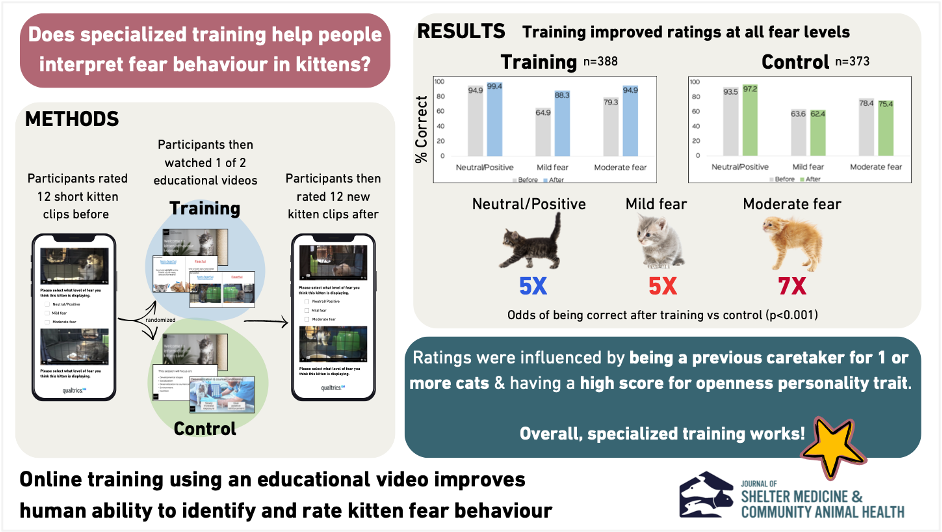Online Training Using an Educational Video Improves Human Ability To Identify and Rate Kitten Fear Behavior
DOI:
https://doi.org/10.56771/jsmcah.v3.91Keywords:
cat, behavior identification, observer rating, welfare, educationAbstract
Introduction: Fear is a negative emotional state that can influence early behavioral development and lead to impairments in animal welfare. For young kittens, excessive fear early in life can instill lasting fearfulness leading to behavioral issues such as aggression, negative impacts on the human–animal bond, potential mistreatment, relinquishment to shelters, and/or euthanasia. Therefore, it is crucial that caretakers can accurately identify when their kittens might be experiencing fear in order to respond appropriately.
Methods: We used an online survey to determine: (1) whether members of the general public (n = 761) can accurately identify and rate different severities of fear behavior in young kittens in short video clips (i.e. no fear requiring no intervention, mild fear requiring awareness of possible intervention, and moderate fear requiring immediate intervention); and (2) whether an educational video offering specialized training on identifying kitten behavior can improve human ability to correctly rate kitten behavior in comparison to a general kitten care video.
Results: Using mixed logistic regression models, we found no difference at baseline in correct ratings between the two video groups across all fear categories. However, participants who received the specialized behavior training had significantly greater odds of being correct after video training for all three categories compared to participants who received the general kitten care video. Additionally, previous experience with cats and participant personality impacted ratings.
Conclusions: Overall, the current study demonstrates that concise and specialized training in identifying kitten behavior is a useful tool for improving human ability to identify and rate fear levels in kittens. This training approach can help strengthen caretaker understanding of kitten behavior to ensure interactions with potentially fear-provoking stimuli are properly mitigated to reduce related welfare impacts. Thus, these types of educational resources are encouraged within shelters, veterinary clinics, research settings, and foster and adoptive homes to improve the welfare of kittens.
Downloads
References
Boissy A. Fear and fearfulness in animals. Q Rev Biol. 1995;70(2):165–191. doi: 10.1086/418981
Levine ED. Feline fear and anxiety. Vet Clin North Am Small Anim Pract. 2008;38(5):1065–1079. doi: 10.1016/j.cvsm.2008.04.010
Salman MD, New JG, Jr., Scarlett JM, Kris PH. Human and animal factors related to relinquishment of dogs and cats in 12 selected animal shelters in the United States. J Appl Anim Welf Sci. 1998;3:207–226. doi: 10.1207/s15327604jaws0103_2
Salman MD, Hutchison J, Ruch-Gallie R, et al. Behavioral reasons for relinquishment of dogs and cats to 12 shelters. J Appl Anim Welf Sci. 2000;3(2):93–106. doi: 10.1207/S15327604JAWS0302_2
DiGiacomo N, Arluke A, Patronek G. Surrendering pets to shelters: the relinquisher’s perspective. Anthrozoos. 1998;11(1):41–51. doi: 10.2752/089279398787000878
Bateson P. Behavioural development in the cat. In: Turner DC, Bateson P, eds. The Domestic Cat: The Biology of Its Behaviour. 3rd ed. Cambridge: Cambridge University Press; 2014:11–26.
Karsh EB. Factors influencing the socialization of cats to people. In: Anderson RK, Hart BL, Hart LA, eds. The Pet Connection: Its Influence on Our Health and Quality of Life. Philadelphia, PA: University of Pennsylvania Press; 1984:207–215.
Karsh EB, Turner DC. The human-cat relationship. In: Turner DC, Bateson PPG, eds. The Domestic Cat: The Biology of Its Behaviour. 1st ed. Cambridge: Cambridge University Press; 1988:159–177.
Lowe SE, Bradshaw JWS. Ontogeny of individuality in the domestic cat in the home environment. Anim Behav. 2001;61(1):231–237. doi: 10.1006/anbe.2000.1545
Bateson P. Behavioural development in the cat. In: Turner D, Bateson P, eds. The Domestic Cat: The Biology of Its Behaviour. 2nd ed. Cambridge: Cambridge University Press; 2000:3–22.
American Veterinary Medical Association. Literature Review on the Welfare Implications of Socialization of Puppies and Kittens. Schaumburg, IL: American Veterinary Medical Association; 2015.
Meagher RK. Observer ratings: validity and value as a tool for animal welfare research. Appl Anim Behav Sci. 2009;119(1–2):1–14. doi: 10.1016/j.applanim.2009.02.026
Feaver J, Mendl M, Bateson P. A method for rating the individual distinctiveness of domestic cats. Anim Behav. 1986;101:1016–1025. doi: 10.1016/S0003-3472(86)80160-9
Haywood C, Ripari L, Puzzo J, Foreman-Worsley R, Finka LR. Providing humans with practical, best practice handling guidelines during human-cat interactions increases cats’ affiliative behaviour and reduces aggression and signs of conflict. Front Vet Sci. 2021;8:714143. doi: 10.3389/fvets.2021.714143
Dawson LC, Cheal J, Niel L, Mason G. Humans can identify cats’ affective states from subtle facial expressions. Anim Welf. 2019;28(4):519–531. doi: 10.7120/09627286.28.4.519
Holden E, Calvo G, Collins M, et al. Evaluation of facial expression in acute pain in cats. J Small Anim Pract. 2014;55(12):615–621. doi: 10.1111/jsap.12283
Flint HE, Coe JB, Pearl DL, Serpell JA, Niel L. Effect of training for dog fear identification on dog owner ratings of fear in familiar and unfamiliar dogs. Appl Anim Behav Sci. 2018;208:66–74. doi: 10.1016/j.applanim.2018.08.002
Terracciano A, Merritt M, Zonderman AB, Evans MK. Personality traits and sex differences in emotion recognition among African Americans and Caucasians. Ann N Y Acad Sci. 2003;1000:309–312. doi: 10.1196/annals.1280.032
Hall JA. Gender effects in decoding nonverbal cues. Psychol Bull. 1978;85(4):845–857. doi: 10.1037/0033-2909.85.4.845
Bahlig-Pieren Z, Turner DC. Anthropomorphic interpretations and ethological descriptions of dog and cat behavior by lay people. Anthrozoos. 1999;12(4):205–210. doi: 10.2752/089279399787000075
Tami G, Gallagher A. Description of the behaviour of domestic dog (Canis familiaris) by experienced and inexperienced people. Appl Anim Behav Sci. 2009;120(3–4):159–169. doi: 10.1016/j.applanim.2009.06.009
Kuroshima H, Hori Y, Inoue-Murayama M, Fujita K. Influence of owners’ personality on personality in Labrador retriever dogs. Psychologia. 2016;59(2–3):73–80. doi: 10.2117/psysoc.2016.73
Plueckhahn TC, Schneider LA, Delfabbro PH. Comparing owner-rated dog temperament measures and a measure of owner personality: an exploratory study. Anthrozoos. 2023;36(1):53–67. doi: 10.1080/08927936.2022.2062870
Kujala MV, Somppi S, Jokela M, Vainio O, Parkkonen L. Human empathy, personality and experience affect the emotion ratings of dog and human facial expressions. PLoS One. 2017;12(1):1–18. doi: 10.1371/journal.pone.0170730
Gosling SD, Rentfrow PJ, Swann WB. A very brief measure of the big-five personality domains. J Res Pers. 2003;37(6):504–528. doi: 10.1016/S0092-6566(03)00046-1
Adolphs R. The biology of fear. Curr Biol. 2013;23(2):R79–R93. doi: 10.1016/j.cub.2012.11.055
McNaughton N. Fear, anxiety and their disorders: past, present and future neural theories. Psychol Neurosci. 2011;4(2):173–181. doi: 10.3922/j.psns.2011.2.002
Leyhausen P. Cat Behavior: The Predatory and Social Behavior of Domestic and Wild Cats. 1st ed. New York, NY: Garland STPM Press; 1979.
Bradshaw JWS, Casey RA, Brown SL. The Behaviour of the Domestic Cat. 2nd ed. Oxfordshire: CABI; 2012.
Johansson GG, Rosset S, Sandström M, Soini H. Increased fear reactions in cats after carbachol administered intraventricularly. Physiol Behav. 1979;22:803–807. doi: 10.1016/0031-9384(79)90318-4
Kessler MR, Turner DC. Stress and adaptation of cats (Felis silvestris catus) housed singly, in pairs and in groups in boarding catteries. Anim Welf. 1997;6:243–254. doi: 10.1017/S0962728600019837
Roberts WW. Rapid escape learning without avoidance learning motivated by hypothalamic stimulation in cats. J Comp Physiol Psychol. 1958;51(4):391–399. doi: 10.1037/h0042900
Dohoo I, Martin W, Stryhn H. Veterinary Epidemiologic Research. 2nd ed. Charlottetown: VER Inc.; 2014.
Blackwell EJ, Bradshaw JWS, Casey RA. Fear responses to noises in domestic dogs: prevalence, risk factors and co-occurrence with other fear related behaviour. Appl Anim Behav Sci. 2013;145(1–2):15–25. doi: 10.1016/j.applanim.2012.12.004
Graham C, Khalife S, Pearl DL, Mason GJ, Niel L. (Accepted in press). Tell-tail fear behaviours in kittens: Identifying the scaredy cat. Animal Behavior and Cognition.
John OP, Srivastava S. The Big Five trait taxonomy: history, measurement, and theoretical perspectives. Handb Personal Theory Res. 1999;2(510):102–138.
Costa PT, McCrae RR. The five-factor model, five-factor theory, and interpersonal psychology. In: Leonard M, Horowitz, Stephen Strack eds. Handbook of Interpersonal Psychology: Theory, Research, Assessment, and Therapeutic Interventions. Hoboken, NJ: John WIley & Sons, Inc; 2012: 91–104. doi: 10.1002/9781118001868.ch6
Cimarelli G, Turcsán B, Range F, Virányi Z. The other end of the leash: an experimental test to analyze how owners interact with their pet dogs. J Vis Exp. 2017;2017(128):1–11. doi: 10.3791/56233
Shih HY, Paterson MBA, Georgiou F, Mitchell L, Pachana NA, Phillips CJC. Two ends of the leash: relations between personality of shelter volunteers and on-leash walking behavior with shelter dogs. Front Psychol. 2021;12:1–14. doi: 10.3389/fpsyg.2021.619715
Finka LR, Ward J, Farnworth MJ, Mills DS. Owner personality and the wellbeing of their cats share parallels with the parent-child relationship. PLoS One. 2019;14(2):1–26. doi: 10.1371/journal.pone.0211862

Published
How to Cite
Issue
Section
License
Copyright (c) 2024 Courtney Graham, Shaela Hurley, David L. Pearl, Georgia J. Mason, Lee Niel

This work is licensed under a Creative Commons Attribution 4.0 International License.








